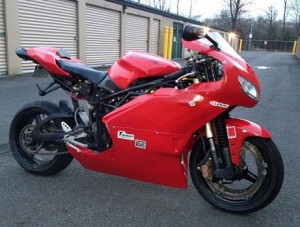Hackstetter Invex998
Apply AWD system on a superbike can be extravagant. The American engineer Rob Hackstetter has been working since 2005 on a sport bike concept with an advanced two-wheel drive.
That large global manufacturer has not shown the slightest interest in AWD systems is not sufficient reason to think that the idea has no future. Or at least has not been for Rob Hackstetter, which in 2007 and patented the first drive system 2×2 with limited slip differential.
Complete the first prototype of the American engineer is the “Invex998 AWD”, a superbike whose development has required design from zero to 90% of its components, including the tubular chassis Cr/Mb. The only existing element is the engine, which also had to make changes to adapt to the transmission.
Hackstetter departed deliberately of a superbike thinking that, if had his way, it would be much easier to integrate the system into a motorcycle without many dynamic requirements, such as a tourer.
The theoretical advantage of full traction applied to a superbike is, of course, the most traction. However, no doubt Hackstetter finger pointing the mistakes made so far by engineers who have dared to try.
The only bike that was saved from burning is the Suzuki Nuda Concept, the mythical prototype unveiled by the Japanese in the Far Hall of Tokyo in 1986. However, Hackstetter criticized the decision to mount a considered too slow, viscous-coupling differential and a drive system to the front wheel with a lateral tilt, which generates forces unwanted in the direction.
To Hackstetter, these errors are responsible approach that AWD has not yet reached sport production bikes. The patented by American engineer is proactive, i.e., does not expect a certain reaction to redistribute power from the engine, but a transmission with electronically controlled torque sensor distributes torque automatically to the front or rear wheel on a tenth of a millisecond.
Under normal conditions, the traction is distributed to 50% between both wheels. If things get tough, the transmission can send a maximum of 80% of the torque to either wheel, taking into account how the decision will affect the weight distribution of the bike, both in terms of acceleration as braking.
Where Hackstetter be more cautious is the arrival of its AWD system to production bikes, although Invex998 show that is actually possible.
